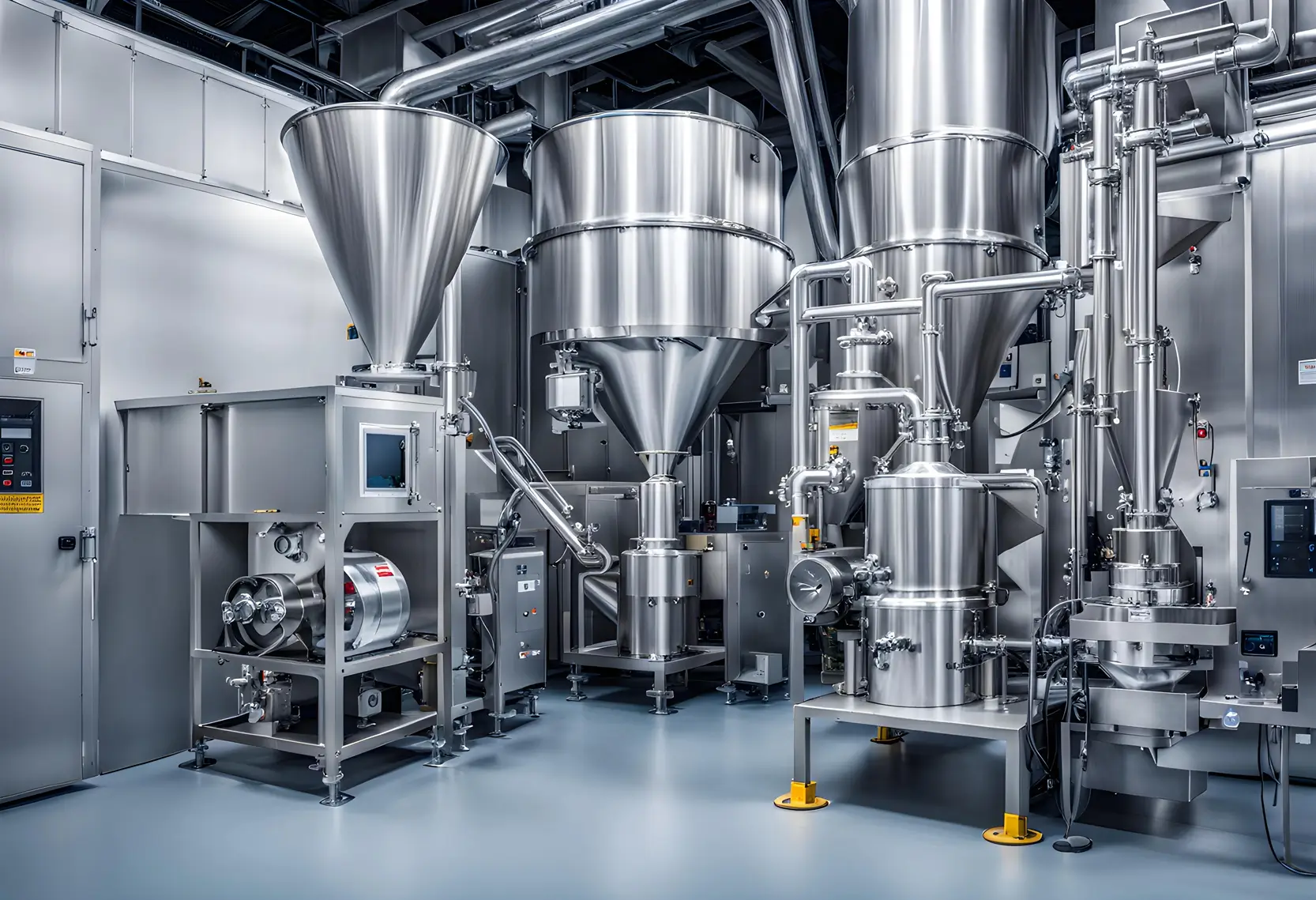
The primary Powder Processing Challenges. in powder handling and processing revolve around effectively controlling the material flow. Unlike liquids, powders, and bulk solids exhibit distinct and sometimes unpredictable flow behaviors. Without proper management, issues such as clumping, bridging, and caking can arise, posing a cascade of problems that impact the quality and safety of the final product. In systems not tailored to the material type, these substances may easily adhere, compromising product quality and safety, and even be able to cause explosive damage to equipment. Moreover, when handling powders and bulk solids in food processing, there are additional safety risks due to their explosive nature, potentially resulting in severe human injuries, equipment damage, or even large-scale disasters.
Powder Flow Behaviors
Understanding the unique characteristics of powder and bulk solids is crucial for effective processing. Unlike liquids, powders exhibit diverse and often challenging flow behaviors. Factors such as particle size, shape, and moisture content contribute to the complexity. Powders can flow erratically, leading to difficulties in maintaining a consistent and controlled material flow. These Powder Processing Challenges. pose a significant hurdle in various industries, including pharmaceuticals, chemicals, and food processing.
Here particle size is a fundamental parameter governing the behavior of powders. The size distribution within a powder mixture influences its flow properties profoundly. Fine powders, characterized by smaller particle sizes, tend to exhibit cohesive behavior due to increased surface area and interparticle forces. In contrast, coarse powders may demonstrate poor flowability, causing challenges in maintaining a consistent material flow. A comprehensive understanding of particle size distribution is crucial for predicting and controlling powder flow in various industrial processes.
Particle Shape and Morphology
The shape of powder particles plays a pivotal role in determining their Powder Processing flow characteristics. Irregularly shaped particles, common in many powders, contribute to interlocking and reduced flowability. Spherical particles, on the other hand, typically exhibit improved flow properties due to reduced interparticle friction. The morphology of powder particles, including surface roughness and porosity, further influences their interactions during flow. An in-depth analysis of particle shape provides valuable insights into the challenges posed by powder handling and aids in devising strategies for efficient material flow.
Moisture Content Impact
The moisture content of powders significantly impacts their flow behaviors. Hygroscopic powders, which readily absorb moisture from the surroundings, may experience clumping and increased cohesion. This phenomenon is particularly relevant in industries where maintaining a low moisture environment is crucial, such as pharmaceuticals and certain chemical processes. Understanding the hygroscopic nature of powders is essential for
preventing flow issues and ensuring the stability of the final product. Rheology, the study of the flow and deformation of materials, is a critical aspect of powder characterization. Powders exhibit complex rheological behaviors influenced by factors such as shear rate, stress, and consolidation. Understanding powder rheology enables the prediction of flow patterns under different processing conditions. This knowledge is instrumental in designing equipment and processes that facilitate optimal powder handling, ensuring a controlled and consistent material flow.
Powder Flow Forces
In regards to powder flow, the interactions between particles are also governed by distinct forces, each playing a crucial role in the behavior of these finely divided substances. Van der Waals forces, arising from temporary dipoles in particles, contribute significantly to cohesive behavior. This cohesive tendency can result in clumping or agglomeration, impacting the overall flow dynamics of the powder. Electrostatic forces, influenced by the charge on particle surfaces, introduce an additional layer of complexity. Particles with similar charges may repel each other, fostering dispersion, while those with opposite charges may attract, leading to aggregation.
Meanwhile, capillary forces come into play in the presence of moisture, further complicating the powder flow dynamics. These forces, arising from the interaction of powder with moisture, contribute to cohesion and influence the overall flow behavior of particles. A meticulous examination of Van der Waals forces, electrostatic forces, and capillary forces is imperative for a comprehensive understanding of powder interactions, providing insights critical for mitigating flow challenges in powder processing.
At the particle level, different forces and interactions dictate the flow of powders, encompassing diverse mechanisms that influence their behavior. These forces include
Van der Waals forces, electrostatic forces, and capillary forces, each play a crucial role in the behavior of finely divided substances. Van der Waals forces, arising from temporary dipoles in particles, contribute significantly to cohesive behavior, leading to clumping or agglomeration. Electrostatic forces, influenced by the charge on particle surfaces, can cause repulsion or attraction between particles, affecting dispersion or aggregation. Capillary forces come into play in the presence of moisture, contributing to cohesion and influencing the overall flow behavior of particles. These forces are influenced by factors such as particle size, shape, surface texture, and moisture content, ultimately impacting the flow properties of the powder.
The presence of electrostatic charges inside a powder is known to influence the material’s flow properties. The triboelectric charges produced at the contacts between the grains and at the contacts between the grains and the container produce electrostatic forces. This can lead to issues such as bad flowability, segregation, and powder build-up, especially when filling powders. The attraction between particles or between particles and a containing boundary influences the flow and packing of powders. Mechanisms that restrict particle movement include friction, mechanical interlocking, and inter-particulate forces of cohesion.
Research has made significant progress in uncovering the connections between interparticle Van der Waals forces and the flowability and compactibility of powders. The findings have demonstrated a clear and substantial impact of these forces on the behavior of powders.
Industry Challenges
Different industries, including pharmaceuticals, chemicals, and food processing, face unique challenges related to powder flow. For instance, pharmaceutical formulations often involve blending powders with varying properties, necessitating a nuanced understanding of powder interactions. In the food industry, where powder ingredients contribute to flavor and texture, ensuring consistent flow is paramount for product quality. Chemical processes, reliant on precise powder handling, demand tailored approaches to overcome challenges associated with specific powder characteristics. In the pharmaceutical industry, the challenges of powder processing manifest in the production of medications with precise dosages and uniform properties. Clumping and inconsistent flow behaviors can jeopardize the quality of pharmaceutical powders, leading to variations in drug formulations. This underscores the critical need for advanced technologies. For instance,
emerging solutions like continuous manufacturing processes and precision powder dispensing systems have gained considerable traction. Continuous manufacturing minimizes batch-to-batch variations and enhances control over powder flow, ensuring a more reliable production process. Additionally, breakthroughs in particle engineering technologies have allowed for the creation of tailor-made powder particles with improved flow characteristics. In laboratories, powder processing challenges are encountered in material synthesis and research. Researchers often grapple with issues such as poor flowability and agglomeration, hindering the synthesis of uniform materials. To address these challenges, innovative techniques like 3D printing of powders and tailored particle design have emerged. These technologies enable precise control over particle size and shape, facilitating improved flow properties and enhancing the reproducibility of experiments.
Safety
Ensuring safety in Powder Processing environments requires a dual focus on both robust safety protocols and heightened human awareness. Particularly crucial in industries handling explosive hazards, such as chemical processing plants, safety measures extend beyond standard procedures. Rigorous safety protocols involve the deployment of specialized equipment to counter electrostatic charges, the use of explosion-proof enclosures, and comprehensive training programs for personnel. Similarly, laboratories working with hazardous powders enforce strict containment measures through the use of fume hoods, glove boxes, and personal protective equipment. This integrated approach, combining advanced safety measures with a well-informed and vigilant human element, is vital for preserving personnel well-being, preventing equipment damage, and mitigating the potential for large-scale disasters in both industrial and laboratory settings.
Final Product Quality
The meticulous efforts invested in manpower, cutting-edge technology, and substantial investments in powder processing can all be undermined if there is a lapse in understanding and addressing the intricacies of bulk solids. The oversight in comprehending particle interactions, chemistry, and the dynamics of powder flow can have a profound impact on the quality of the final product. Instances where powders clump or form bridges during processing directly compromise the homogeneity of the end product. This disruption in uniformity may lead to uneven distribution of additives or active ingredients, thereby affecting the overall efficacy of pharmaceuticals or the sensory attributes of food products, such as flavor and texture.
Moreover, the adherence of powders to surfaces within processing equipment introduces impurities, posing an additional threat to product quality. These impurities can alter the intended composition and characteristics of the final product. To safeguard against these challenges, manufacturers must prioritize investments in optimized powder handling systems. This involves a comprehensive understanding of particle interactions and chemistry and integrating advanced technologies to ensure a controlled and consistent material flow. By addressing these factors, manufacturers can uphold the integrity of their end products, meeting stringent quality standards and maximizing the benefits of their powder processing endeavors.




